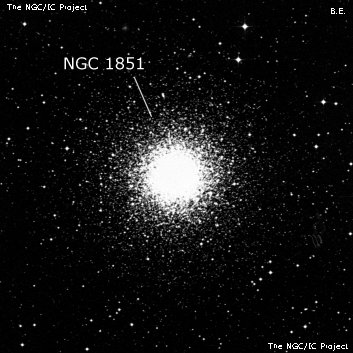
James Dunlop discovered NGC 1851 = D 508 = h2777 on 10 May 1826 with his 9-inch speculum f/12 reflector at Parramatta, New South Wales. His decription reads "exceedingly bright, round, well-defined nebula, about 1.5' diameter, exceedingly condensed, almost to the very margin. This is the brightest small nebula that I have seen. I tried several magnifying powers on this beautiful globe; a considerable portion round the margin is resolvable, but the compression to the centre is so great that I cannot reasonably expect to separate the stars. I compared this with the 68 Conn. des Tems, and this nebula greatly exceeds the 68 in condensation and brightness." Dunlop observed it 5 times.
John Herschel recorded it on 23 Oct 1835 as a "superb globular cluster; all resolved into stars of 14th mag.; very suddenly much brighter in the middle to a blaze or nucleus of light; diam. in RA = 15 seconds of time. Difference of left and right eyes in resolving this cluster very remarkable. Returning from the left to the right eye, the object (in comparison) appears as if glazed over with a kind of dull film." On a later sweep he wrote, "very bright; round; very suddenly very much brighter in the middle; 3'; all clearly resolved into stars from 14 to 16 mag except at the centre, where they are massed together into a blaze of light." His final observation reads "Superb globular cluster, very bright; round; first very gradually then suddenly very much brighter in the middle; 4'; resolved, the stars barely visible in strong twilight."
200/250mm - 8" (10/13/81): small, very small bright core, faint halo.
300/350mm - 13.1" (2/20/04 - Costa Rica): at 200x, this compact globular was very bright, strongly concentrated with an intense 1.5' core and a 4-5' fainter halo. The core was very lively and there were ~30 stars resolved [brightest cluster members are mag 13.2], mostly in the loose halo. A neat loop of stars emerges from the core and runs NNE-SSW along the west edge of the core.
13.1" (1/1/84): mottled bright core, unresolved except for two or three faint stars at the west edge.
400/500mm - 17.5" (1/31/87): small bright core, large very mottled halo. About 20 stars are resolved, mostly west of the core.
Notes by Steve Gottlieb